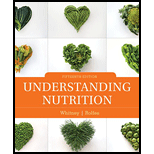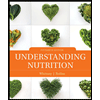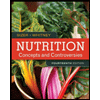
Concept explainers
To determine: The reason why consumers continue to pursue fad diets.
Introduction: The practice of regulating and supervising the food habits in order to maintain, decrease or increase the body weight, or to prevent the diseases is known as dieting. A fad diet is referred as weight-loss diet that promises a fast loss in weight. These types of diets include baby foods, ketogenic diet, paleo diet, and intermittent fasting. These are generally unhealthy.
To explain: The way to design a weight loss plan that would be appealing to most people and produce long-lasting results.
Introduction: A practice of regulating and supervising the food habits in order to maintain, decrease or increase body the weight, or to prevent the diseases is known as dieting. A fad diet is referred as weight-loss diet that promises a fast loss in weight. These types of diets include baby foods, ketogenic diet, paleo diet, and intermittent fasting. These are generally unhealthy.
Want to see the full answer?
Check out a sample textbook solution
Chapter 9 Solutions
Understanding Nutrition (MindTap Course List)
- Which of the following statements is not true? a. Essential nutrients can be synthesized by the body. b. Vitamins are required in small quantities for bodily function. c. Some amino acids can be synthesized by the body, while others need to be obtained from diet. d. Vitamins come in two categories: fat-soluble and water-soluble.arrow_forwardWhen a child has a chronic condition that limits activity, such as spina bifida, what is the greatest long-term nutrition concern? a. Protein limiting growth b. Modified food textures to avoid eating difficulties c. Excessive calorie intake further limiting mobility d. Intake of calcium and vitamin D to prevent bone fracturesarrow_forwardFigure 16.7 Which of the following statements about the digestive system is false? a. Chyme is a mixture of food and digestive juices that is produced in the stomach. b. Food enters the large intestine before the small intestine. c. In the small intestine, chyme mixes with bile, which emulsifies fats. d. The stomach is separated from the small intestine by the pyloric sphincter.arrow_forward
- Figure 34.12 Which of the following statements about the small intestine is false? Absorptive cells that line the small intestine have microvilli, small projections that increase surface area and aid in the absorption of food. The inside of the small intestine has many folds, called villi. Microvilli are lined with blood vessels as well as lymphatic vessels. The inside of the small intestine is called the lumen.arrow_forwardWhat are the main functions of the stomach? What roles do enzymes and hormones play?arrow_forward
 Understanding Nutrition (MindTap Course List)Health & NutritionISBN:9781337392693Author:Eleanor Noss Whitney, Sharon Rady RolfesPublisher:Cengage Learning
Understanding Nutrition (MindTap Course List)Health & NutritionISBN:9781337392693Author:Eleanor Noss Whitney, Sharon Rady RolfesPublisher:Cengage Learning Concepts of BiologyBiologyISBN:9781938168116Author:Samantha Fowler, Rebecca Roush, James WisePublisher:OpenStax College
Concepts of BiologyBiologyISBN:9781938168116Author:Samantha Fowler, Rebecca Roush, James WisePublisher:OpenStax College Nutrition: Concepts and Controversies - Standalo...Health & NutritionISBN:9781305627994Author:Frances Sizer, Ellie WhitneyPublisher:Brooks Cole
Nutrition: Concepts and Controversies - Standalo...Health & NutritionISBN:9781305627994Author:Frances Sizer, Ellie WhitneyPublisher:Brooks Cole





